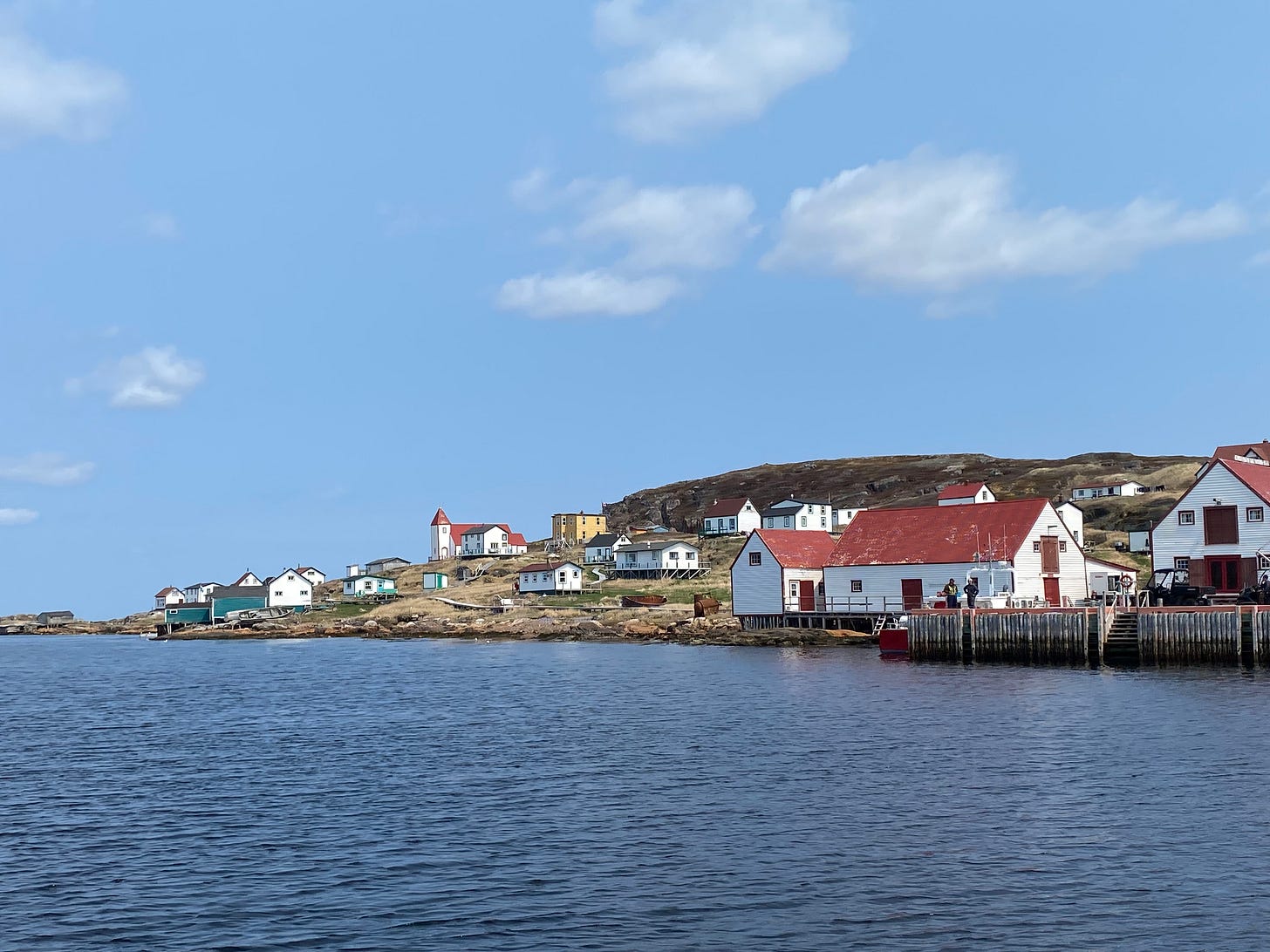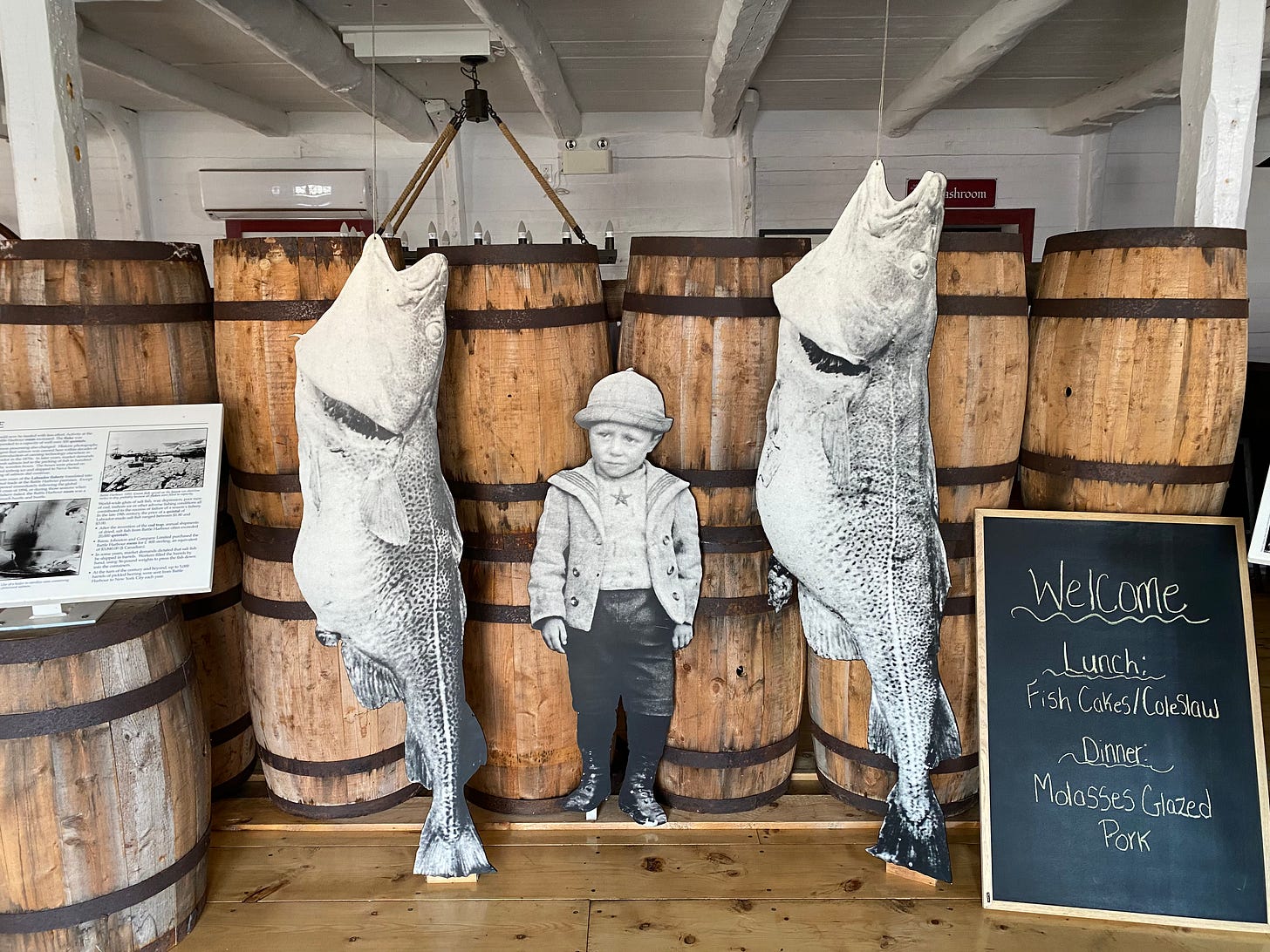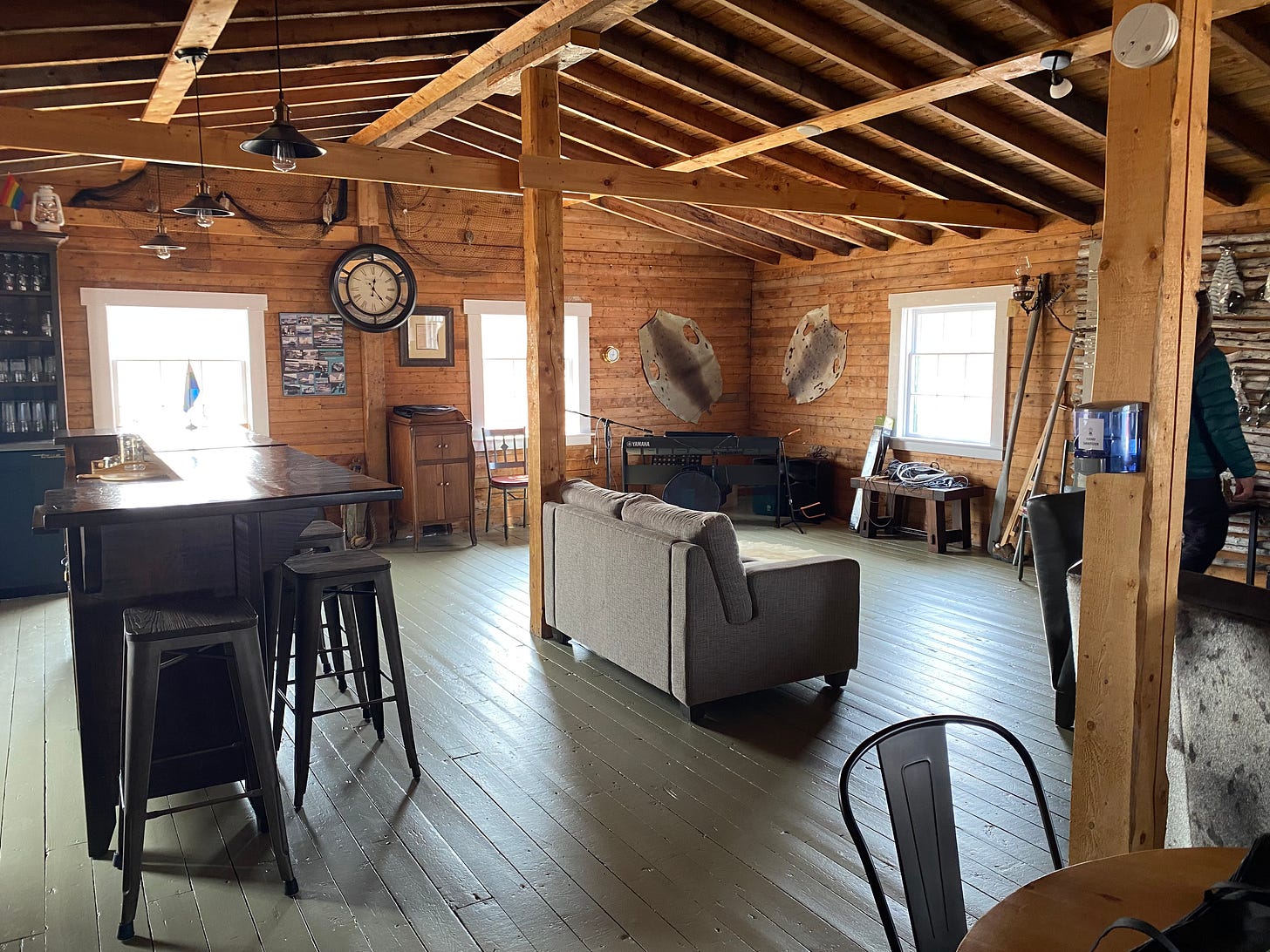To visit Battle Harbour is to step back in time, to the days when Cod was King in Labrador, before the 1992 cod moratorium. When the island was abandoned it was donated to a Historic Trust, which later restored the dilapidated buildings and opened the island to visitors.
There are no private homes on Battle Island. A guest eats and sleeps in restored historic buildings, enjoys a remote and beautiful landscape and seascape, and learns about a way of life that no longer exists.
The Battle Harbour website has beautiful photographs and a short film — you can hear the cadence and accent of the local folk who keep their island alive.
Getting to Battle Harbour
We said goodbye to our iceberg and left St. Lewis quite early on Monday morning. At Mary’s Harbour we, and ten other guests, took a boat ride to Battle Island, leaving at eleven and arriving shortly after noon. We were the first crop of guests for the 2025 season, a fact that determined the timing of our entire stay in Labrador.
Arrival in Battle Harbour
As our boat neared the tickle we passed this fantastical “bubbly” iceberg:
This is the view upon arrival to Battle Harbour:
As soon as we disembarked we learned two important facts:
1) the Board of Directors was having their yearly meeting during our stay, and
2) both of the generators had failed so the island was without power.
The staff were all punting. They improvised to provide us hot food, beginning with lunch. They also stoked the wood stoves in each building to keep us warm. The temperature was in the low 40s. Everyone knew it would dip below freezing overnight.
Lunch was served in the dining room — fish cakes with homemade pickles and a little cup of coleslaw, as well as homemade bread and butter.
“Salmon is Salmon but Cod is Fish”
Nelson Smith is the fifth generation of his family to live on this harbour. For nearly two hours he took us through the various buildings, each with its own purpose.
The subjects covered were cod-fishing, salting and drying of cod, and a bit about the seal industry. I’ve seen displays on these subjects over the years, but it felt authentic to learn more in buildings that once housed these activities.
Battle Harbour had an early Marconi station, and one of the island’s glory moments was when Robert Peary gave a press conference announcing (his most likely untrue claim) that he had reached the North Pole in his 1908-09 expedition.
The tour ended in the Anglican church. The original pump organ, nearly 200 years old, was still in working condition. A member of our group sat down and played a verse of Amazing Grace. Here are a few bars:
On the way out, I rang the church bell three times — it was just past three.
Even More Historical than Anticipated
Supper that night was pork with mashed potatoes and cabbage. The cooks apologized that they had to skillet-fry the pork since they couldn’t use the oven.
Despite a number of hopeful moments, the generators were still quiet. We spent the night without electricity, meaning no light source or heat in our room, which had been updated to use electric heat. We were warm enough because one of our walls was shared with a common area that had a wood stove, which Doug and other guests stoked as necessary.
In addition to that, the water feeding the bathtub had a great deal of debris in it — we couldn’t take a much-anticipated shower. Since we couldn’t recharge our devices, I couldn’t use my laptop for long. I carefully conserved my phone for photos the next day.
Our Day at Battle Harbour
After a breakfast of pancakes, Doug and I explored the island on a network of hilltop trails. The sky was a panoply of clouds. We counted eight icebergs along the horizon — a nearly complete circle of water around us. The hilltop was all ours.
Lunch was moose stew, which was delicious and warming. By now the Board of Directors had joined us, and we talked with a number of members, including Peter Bull, the Executive Director, Geoff Goodyear, a retired helicopter pilot, Fred Earle, whose family originated the Historic Trust, and Tom Paddon, a mining executive and cultural educator.
We also met a new group preparing to lead a tour by Natural Habitat Adventures. After lunch we joined them and crossed the tickle by boat for a guided hike on nearby Great Caribou Island.
Our guide was Peter, the ED of the Historic Trust. He led us on a hike for nearly three hours. The terrain was either bare rock or spongy tundra plant matter, which sank underfoot. We identified crowberry, Labrador tea, caribou moss, map lichen, rock tripe, and cotton grass.
Lots of snow patches. Many pools of water. We saw the tubing which connects one pool to Battle Harbour as a water source. (And understood why the bathtub water was full of debris.)
We saw lots of cormorants (devil birds!) and a few red-throated loons. The turnaround point of our hike was a hill with some Arctic Fox burrows. The burrows had plenty of evidence of life (below), but we did not spy the foxes. (One roamed Battle Island, his white coat shaggy.)
Evenings at Battle Harbour
After the hike, people gathered in the Loft, an upstairs lounge where the wood stove roared. As I sat in a chair upholstered with sealskin, I thought about people I know who might find my seal seat upsetting!
Supper was cod and potatoes. Afterward we returned to the Loft, where Peter now served as our bartender. (The pastor in me recognized his Jack-of-all-Trades role.)
Sometime in the early evening the lights came on! We were able to charge our devices and enjoy lights and heat from that point.
Leaving Battle Harbour
Breakfast was served at 8:00 and we were on the ferry to Mary’s Harbour by 9:00. We hoped to catch the ferry from Blanc Sablon (Quebec) to St. Barbe (Newfoundland) at 1:00, which meant quite a drive along coastal Labrador. We’d been warned that we wouldn’t make it. Luckily, it was no problem. We were once again the last vehicle to board the ferry, but it’s like the old joke: What do you call a college graduate with a D+ average? (LMK in the comments!)
One funny thing is that we stopped to tank up in West St. Modeste and the gas pump malfunctioned. There was no way to tell how much gas Big Blue had slurped up. Fortunately Doug had just said aloud how many miles were left on the tank, and he knew the tank held 100 liters. So we could estimate, which seemed to satisfy everyone.
Oh, and I did see a moose in Labrador, just south of Red Bay. It was a cow, lifting her head from a pool — water dripping from its long muzzle. I squealed and pointed but it disappeared before Doug could spot it. For being such large animals, moose are masters at dematerializing.












Answer: a college graduate
At the Naval Academy the graduate with the lowest GPS was called the goat. In my experience, they are simply called a graduate! What lovely experiences you and Doug are having!